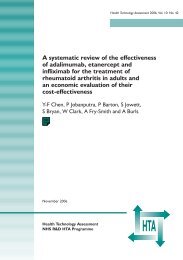Measuring Athlete Imagery Ability: The Sport ... - ResearchGate
Measuring Athlete Imagery Ability: The Sport ... - ResearchGate
Measuring Athlete Imagery Ability: The Sport ... - ResearchGate
Create successful ePaper yourself
Turn your PDF publications into a flip-book with our unique Google optimized e-Paper software.
418 Williams and Cumming<br />
of arousal and cognition) function for athletes (Paivio, 1985). <strong>The</strong> learning and<br />
enhancement of movement performance, on the other hand, is categorized as<br />
a cognitive-specific (CS; i.e., images of skills) function. Other functions are<br />
cognitive general (CG; i.e., images of strategies, game plans, and routines) and<br />
motivational specific (MS; i.e., images of process, performance, and outcome<br />
goals). Hall, Mack, Paivio, and Hausenblas (1998) further subdivided the MG<br />
function into motivational general-arousal imagery (MG-A; i.e., images of affect,<br />
mood, and emotions) and motivational general-mastery imagery (MG-M; i.e.,<br />
images of mastery cognitions). <strong>Athlete</strong>s report using imagery for all five of these<br />
functions, with motivational imagery the most frequently reported (Cumming &<br />
Hall, 2002; Hall et al., 1998).<br />
<strong>The</strong> imagery functions are thought to elicit different types of imagery content<br />
following the principle outlined by Martin et al. (1999) of “what you see, really is<br />
what you get” (p. 260). For example, athletes intending to improve performance<br />
of a specific skill will image themselves executing this skill. However, Murphy<br />
et al. (2008) and others (e.g., Cumming & Ramsey, 2009; Callow & Hardy,<br />
2001) argue that these concepts are not identical and there is a need to separate<br />
function (i.e., why athletes image) from content (i.e., what athletes image). This<br />
is because research has demonstrated that images can serve multiple functions<br />
for athletes (Nordin & Cumming, 2008; Short, Monsma, & Short, 2004). For<br />
example, two hurdlers may image performing the correct hurdling technique,<br />
but one may use this image to improve their hurdling performance (CS function)<br />
while the same content may be used to improve the other’s confidence at<br />
hurdling (MGM function).<br />
With regards to imagery ability, the focus is on measuring the individual’s<br />
ability to generate imagery content, not why they are imaging this content. However,<br />
a gap currently exists between the imagery content commonly reported by<br />
athletes and how their ability to generate this content is typically assessed (Hall,<br />
1998). As stated by Paivio (1985), “[t]here is no single best measure [when assessing<br />
imagery ability] and the trick is to find [a method] that is most directly related to<br />
the specific task under consideration” (p. 27S). For example, Cumming and Ste-<br />
Marie’s (2001) five-week cognitive and motivational imagery intervention led to<br />
significant improvements in participants’ ability to image skate specific images.<br />
However, these changes did not generalize to increased MIQ-R scores, which<br />
remained the same as baseline. This finding reinforces the need for an imagery<br />
ability measure of sport related content that can be used to more accurately screen<br />
participants, thus more effectively controlling for individual differences, as well as<br />
detecting improvements. To our knowledge, the literature currently lacks a valid<br />
and reliable measure to assess athletes’ ability to image content reflecting the five<br />
imagery functions (i.e., CS, CG, MS, MGA, and MGM imagery).<br />
In recent years, Gregg and Hall (2006) have made progress toward filling this<br />
gap by developing the Motivational <strong>Imagery</strong> <strong>Ability</strong> Measure for <strong>Sport</strong> (MIAMS).<br />
<strong>The</strong> MIAMS assesses participants’ ease and level of emotion experienced following<br />
the generation of eight motivational general images (i.e., four MGA and four<br />
MGM images). Although the authors have provided evidence to support the validity<br />
and reliability of the questionnaire, the MIAMS is limited to the assessment<br />
of motivational general imagery only, to the exclusion of MS imagery and both<br />
forms of cognitive imagery.
















